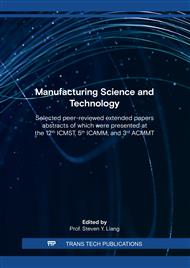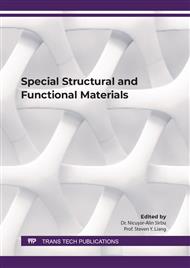[1]
Silicon carbide -- Britannica Online Encyclopedia,, Encyclopaedia Britannica, Inc., Aug. 28, 2008. https://www.britannica.com/science/silicon-carbide (accessed Sep. 24, 2021).
Google Scholar
[2]
T.C. Martin, Ed., electricalworld,, McGraw publishing componey, (1907).
Google Scholar
[3]
J. A. Lely, SUBLIMATION PROCESS FOR MANUFACTURING SILICON CARBIDE CRYSTAS,, (1958).
Google Scholar
[4]
Y. M. Tairov and V. F. Tsvetkov, Investigation of growth process of ingots of silcon carbide single crystals,, (1978).
Google Scholar
[5]
D.L. Barrett, SiC boule growth by sublimation vapor transport,, journal of crystal growth, p.17–23, (1991).
DOI: 10.1016/0022-0248(91)90152-u
Google Scholar
[6]
H. Matsunami and T. Kimoto, Step-controlled epitaxial growth of SiC: high quality homoepitaxy.,.
Google Scholar
[7]
Sic Materials and Devices SEMICONDUCTORS AND SEMIMETALS.,.
Google Scholar
[8]
M. I. Z. Z. M. I. F. (Fei) W. F. I. (Invited Shiqi Ji, Overview of High Voltage SiC Power Semiconductor Devices: Development and Application,, (2017).
Google Scholar
[9]
T. Motor Corporation, Toyota to Trial New SiC Power Semiconductor Technology,, (2015).
Google Scholar
[10]
G. L. Harris, Properties of Silicon Carbide,.
Google Scholar
[11]
X. Shiyu, High quality 4H-SiC crystal growth and dislocations behavior during solution method.,.
Google Scholar
[12]
Y. M. Tairov and V. F. Tsvetkov, INVESTIGATION OF GROWTH PROCESSES OF INGOTS OF SILICON CARBIDE SINGLE CRYSTALS,, (1978).
DOI: 10.1016/0022-0248(78)90169-0
Google Scholar
[13]
T. Kimoto, Bulk and epitaxial growth of silicon carbide,, Progress in Crystal Growth and Characterization of Materials, vol. 62, no. 2. Elsevier Ltd, p.329–351, Jun. 01, 2016.
DOI: 10.1016/j.pcrysgrow.2016.04.018
Google Scholar
[14]
D.L. Bsrrett, sic boule growth by sublimation vapor transport,.
Google Scholar
[15]
SiC: More valuable than diamonds?, https://www.rohm.com/blog/-/blog/id/6628435 (accessed Sep. 24, 2021).
Google Scholar
[16]
F. C. Frank, Capillary Equilibria of Dislocated Crystals,, (1951).
Google Scholar
[17]
fundamentals of silicon carbide technology,.
Google Scholar
[18]
M. H. Hong, A. v. Samant, and P. Pirouz, Stacking fault energy of 6H-SiC and 4H-SiC single crystals,, Philosophical Magazine A: Physics of Condensed Matter, Structure, Defects and Mechanical Properties, vol. 80, no. 4, p.919–935, 2000,.
DOI: 10.1080/014186100250615
Google Scholar
[19]
N. Ohtani, M. Katsuno, J. Takahashi, H. Yashiro, and M. Kanaya, Impurity incorporation kinetics during modified-Lely growth of SiC,, Journal of Applied Physics, vol. 83, no. 8, p.4487–4490, Apr. 1998,.
DOI: 10.1063/1.367234
Google Scholar
[20]
T. M. K. W. E. H. H. T. S. I. N. K. A. Tomohisa Kato, Defect and Growth Analysis of SiC Bulk Single Crystals with High Nitrogen Doping,, Materials Science Forum , vol. 556–557, p.239–242, (2007).
DOI: 10.4028/www.scientific.net/msf.556-557.239
Google Scholar
[21]
Kato T, Growth of low resistivity n-type 4H-SiC bulk crystals by sublimation method using co-doping technique[J],, Materials Science Forum, vol. 780, p.47–50, (2014).
DOI: 10.4028/www.scientific.net/msf.778-780.47
Google Scholar
[22]
H. M. Hobgood et al., Semi-insulating 6H-SiC grown by physical vapor transport,, (1995).
Google Scholar
[23]
H. Shiomi, H. Kinoshita, T. Furusho, T. Hayashi, M. Tajima, and E. Higashi, Crystal growth of micropipe free 4H-SiC on 4H-SiC{0 3 over(3, -) 8} seed and high-purity semi-insulating 6H-SiC,, Journal of Crystal Growth, vol. 292, no. 2, p.188–191, Jul. 2006,.
DOI: 10.1016/j.jcrysgro.2006.04.004
Google Scholar
[24]
L. Zhou, V. Audurier, P. Pirouz, and J. A. Powell, Chemomechanical Polishing of Silicon Carbide,, Journal of The Electrochemical Society, vol. 144, no. 6, pp. L161–L163, Jun. 1997,.
DOI: 10.1149/1.1837711
Google Scholar
[25]
Jian Xiu, SuJia Xi, and DuXing Long LiuHai Na Liu, Study on Material Removal Rate of CMP 6H-SiC Crystal Substrate (0001) C Surface Based on Abrasive Alumina,, 2011,.
DOI: 10.1016/j.proeng.2011.11.2673
Google Scholar
[26]
T. Kimoto, H. Nishino, W. S. Yoo, and H. Matsunami, Growth mechanism of 6H-SiC in step-controlled epitaxy,, Journal of Applied Physics, vol. 73, no. 2, p.726–732, 1993,.
DOI: 10.1063/1.353329
Google Scholar
[27]
The growth of crystals and the equilibrium structure of their surfaces,, Philosophical Transactions of the Royal Society of London. Series A, Mathematical and Physical Sciences, vol. 243, no. 866, p.299–358, Jun. 1951,.
DOI: 10.1098/rsta.1951.0006
Google Scholar
[28]
F. la Via, M. Camarda, and A. la Magna, Mechanisms of growth and defect properties of epitaxial SiC,, Applied Physics Reviews, vol. 1, no. 3. American Institute of Physics Inc., Sep. 01, 2014.
DOI: 10.1063/1.4890974
Google Scholar
[29]
H. Pedersen, Chloride-based Silicon Carbide CVD. Linköping University Electronic Press, (2008).
Google Scholar
[30]
N. Ohtani et al., Propagation behavior of threading dislocations during physical vapor transport growth of silicon carbide (SiC) single crystals,, Journal of Crystal Growth, vol. 286, no. 1, p.55–60, Jan. 2006,.
DOI: 10.1016/j.jcrysgro.2005.09.030
Google Scholar
[31]
T. Höchbauer, C. Heidorn, and N. Tsavdaris, New SiC epitaxial growth process with up to 100% BPD to TED defect conversion on 150mm hot-wall CVD reactor,, in Materials Science Forum, 2019, vol. 963 MSF, p.123–126.
DOI: 10.4028/www.scientific.net/msf.963.123
Google Scholar
[32]
P. G. N. J. A. P. and L. G. M. David J. Larkin, Site‐competition epitaxy for superior silicon carbide electronics,, Applied Physics Letters 65.13:1659-1661., (1994).
DOI: 10.1063/1.112947
Google Scholar



